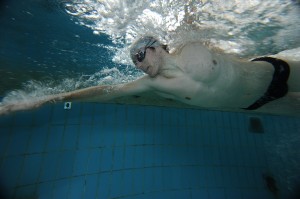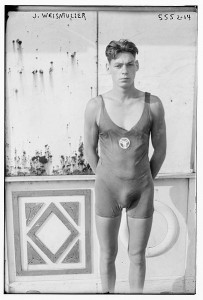 |
| Photo: Michael Rauschendorfer |
Now that I haven't swum a single meter for 3 months, it's time to get started again this evening. Immediately after the (season) break it is important to swim only short sections, otherwise bad technique will set in after a few hundred meters, and all you practice is unclean swimming. Especially after a long break, the body is receptive to new movement patterns. Therefore, at the beginning I only swim 25m intervals, but in these I try to perform the technique as well as possible. I make the breaks in between so long that I start every further interval rested. I pay particular attention to the high elbows underwater and a stable trunk. In addition, I do dry exercises on my Chuck-Norris swimming bench to practice the high elbow and this sequence of movements with hundreds of correct Hammering repetitions into the brain.
I used to believe that the position in the water and the streamlining are the decisive factors. In the meantime my opinion has changed. To be able to swim really fast you need pressure in the underwater phase. It starts with grabbing water with your hand and feeling the water resistance, continues with raising your arm (high elbow), from which you can ultimately “pull” your body forward by making optimal use of the water resistance. Only then will you reach speeds at which it is worth honing the rest of the technique.
Johnny Weißmüller in the 20s of the last century
 |
| Source: Library of Congress Prints and Photographs Division Washington, DC 20540 USA |
To illustrate: In the 1920s, Johnny Weißmüller swam a time of 58 seconds over 100m using a technique that is now known as "water polo crawl", i.e. with his head above water !! So in terms of swimming technique, more than questionable from today's sport-scientific knowledge. Because you know that when the head goes out of the water, the legs automatically sink. Which leads to an extremely bad water situation. Nevertheless, he achieved this very fast time, even by today's standards, and left all his competitors behind at that time.
He has more than 50 world records and has never been beaten in any of his official races. At that time he was the first swimmer to understand the importance of the high elbow in the underwater phase. I dare to predict that even today, after almost 100 years, 98% of all swimmers will bite their teeth at this 100m time.
And now let's face it, with this cotton suit that he was wearing, it cost him at least another 2-3 seconds on the 100m. Other aggravating circumstances that made this time appear even more impressive were, on the one hand, that the starting jump as we know it today was more like a belly-slap back then, and on the other hand, that outdoor pool lengths of 100 meters and more were not unusual. Up until the 1930s there was an outdoor swimming pool of 200 in Nuremberg! Meters in length. This of course means that the advantage of turning after 50 meters, which is common today and which times continue to accelerate, simply did not come into play in the past.
skin in!
krelli


Hey Krelli,
then let it crack. I'm also slowly sneaking into training again.
Have fun
Jan
thank you Jan, rock`n roll !!